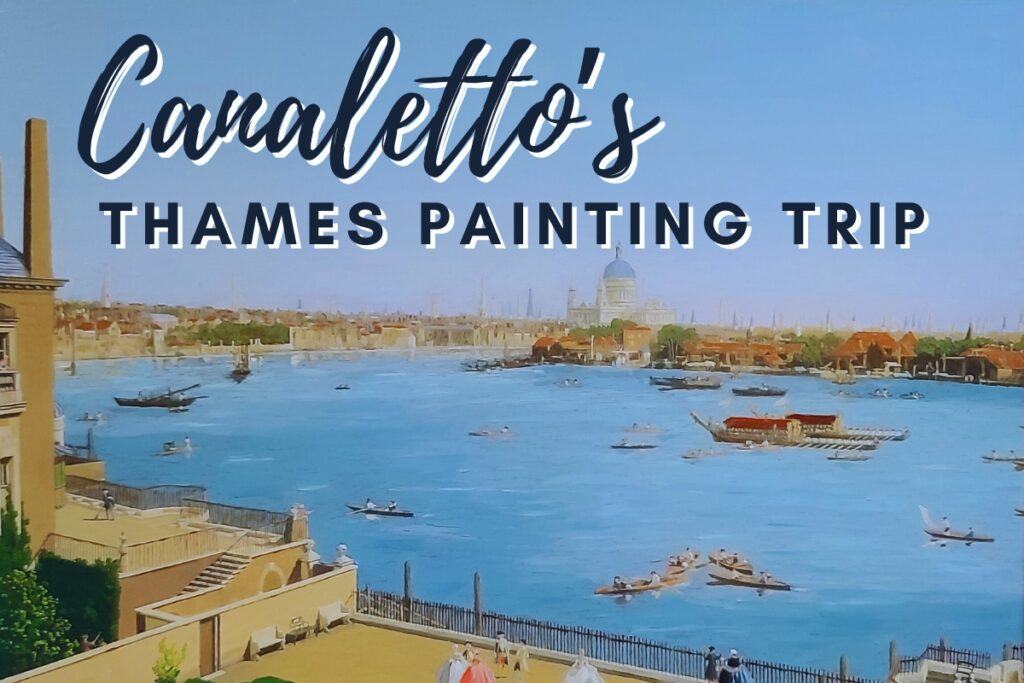
Canaletto’s Thames Painting Trip
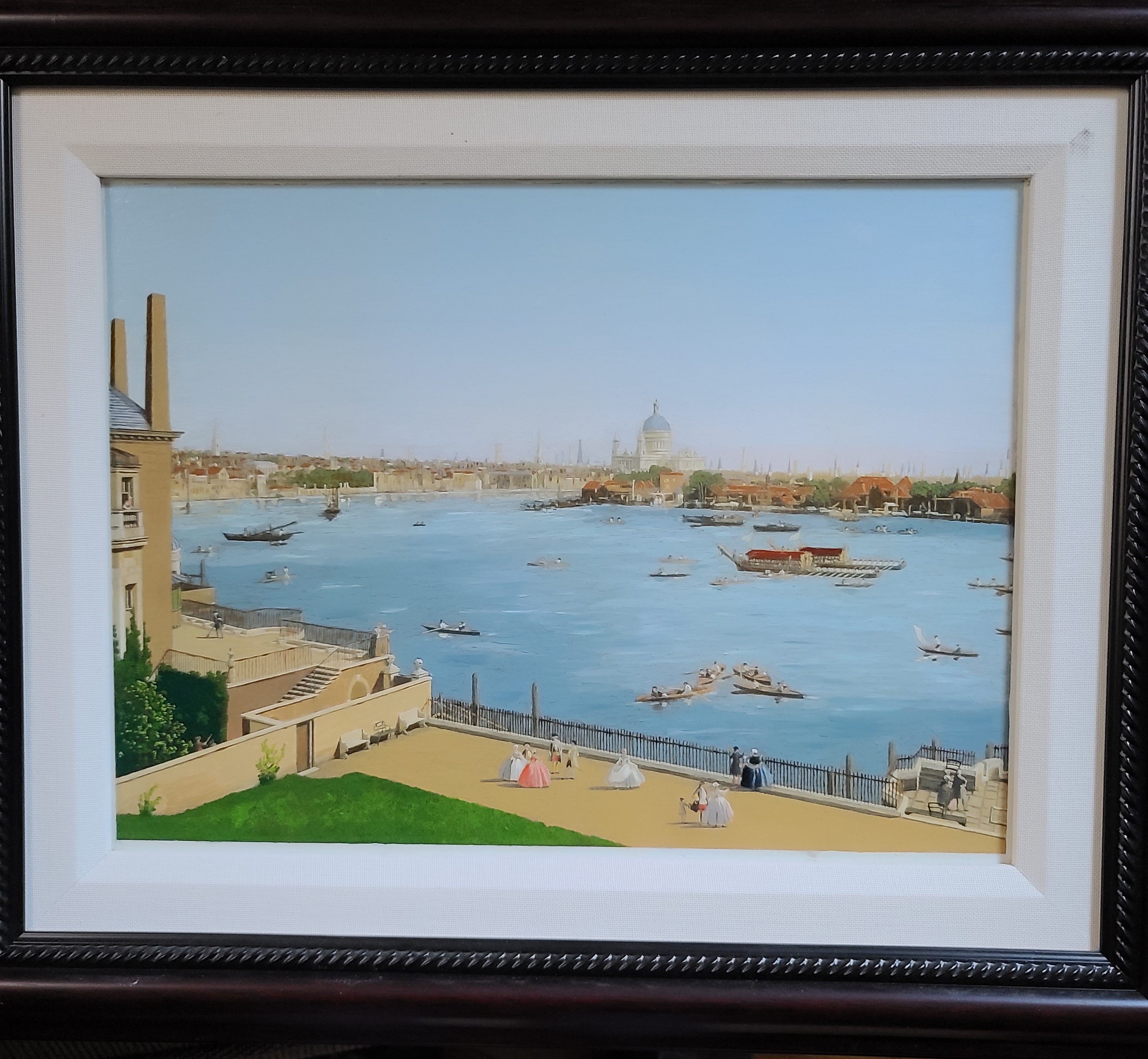
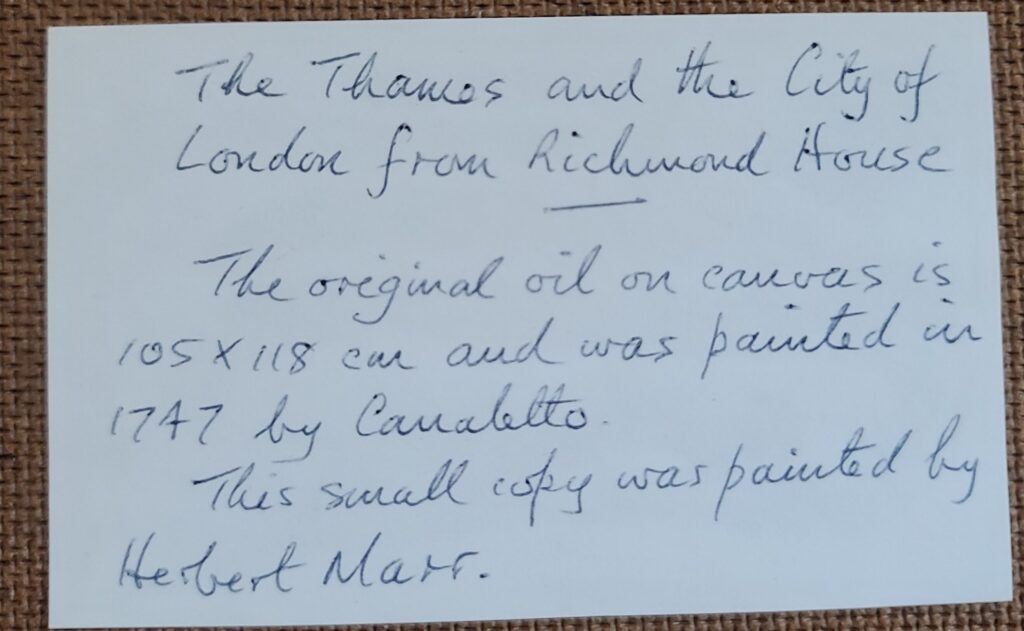
Paintings take you on journeys. This painting invoked both actual travel plus imagined trips of connection and coincidence.
The Thames and the City of London from Richmond House was painted by Canaletto in 1747. My father painted a miniature copy – I teased him that his retirement hobby made him a master forger. The first physical journey was to bring the copy from Nova Scotia to my home in Manitoba following the death of my mother. Not unlike my whim to bring home A Lake Near Copenhagen following the death of my father, I was in a rush to select a painting.
I decided to take a Canaletto from the sunroom, one of Canaletto’s many views of Venice. But the copy was not one of my father’s best efforts and he had been unhappy with it. Then I spotted another Canaletto, in pride of place in the living room. That is the one I put in my suitcase.
Once home I realized that while indeed a Canaletto, it was not of Venice. Initially I was disappointed. Venice was on my mind because I was leaving shortly to run my rowing trip to the Vogalonga. I have a conflicted relationship with Venice. It is a magnificent city which has previously awed me. Now I am just overwhelmed by the tourist hordes which I acknowledge are there for the same reasons as me. I have a wonderful memory of a day in Venice when I had a meeting with a hotel during the pandemic. The city was quiet. In brilliant sunshine I took an almost empty vaporetto from the train station to the Lido, progressing slowly down Cannaregio and the Grand Canal past St. Marks Square. Canaletto’s Venice paintings are often crowded with boats on the water and people on the land, but they appear calm and luminous, filled with sky and the spectacular skyline. This is how I want to think of the city.
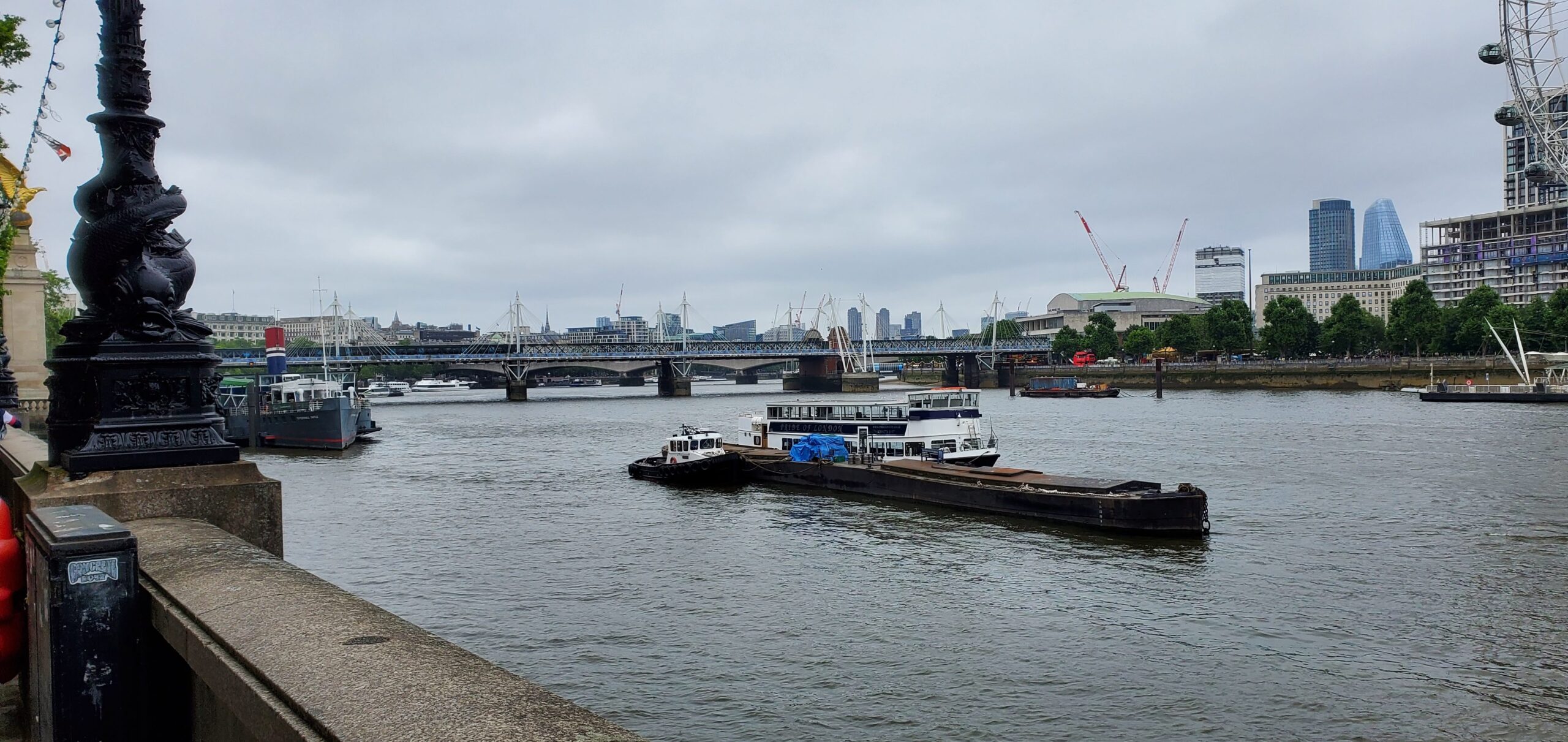
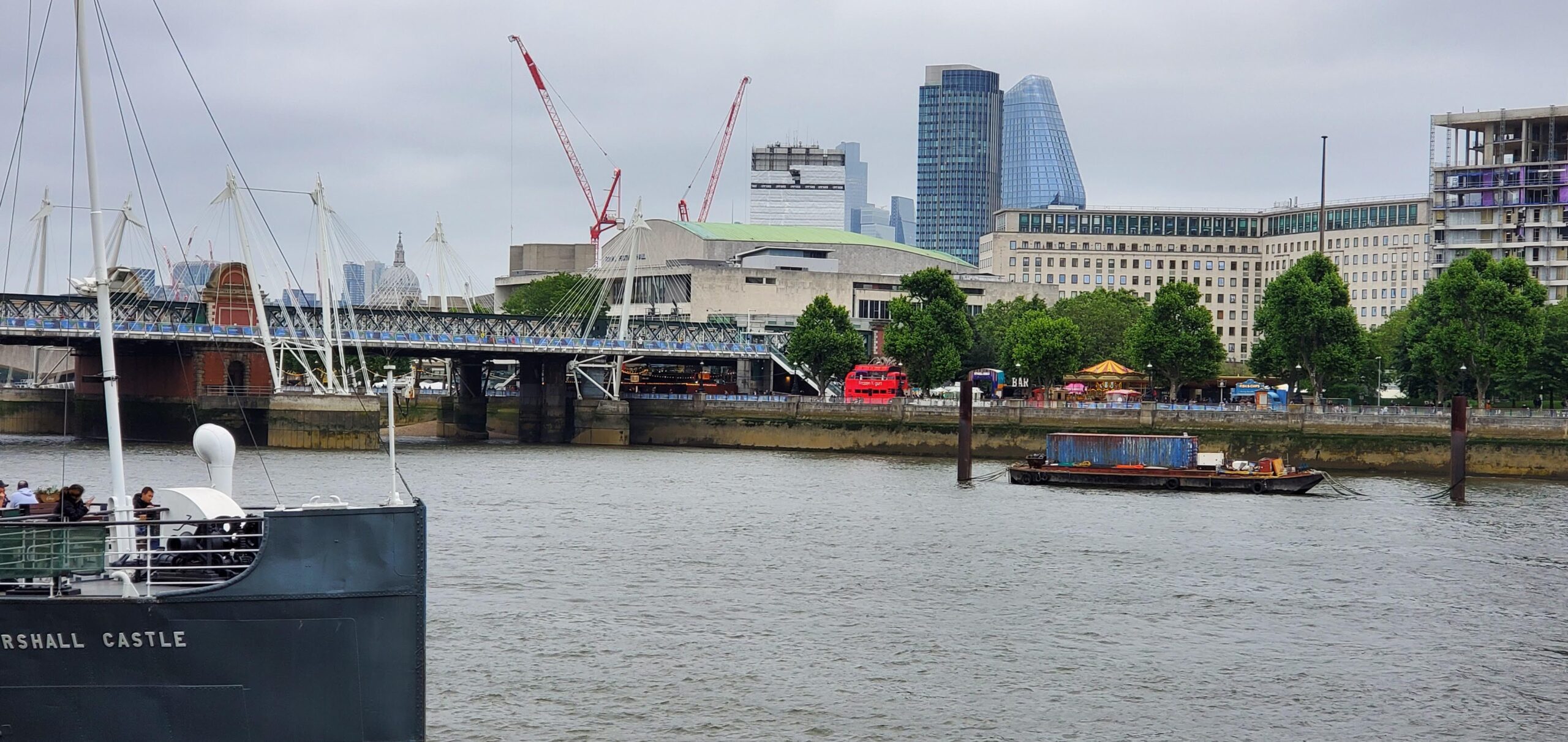
Canaletto paints the Thames
This Thames painting bore similarities to the Venice paintings with a big pale blue sky, yellow white buildings, church spires and the canvas dominated by the river with boats seeming to glide by. There is the same attention to detail within a vast scale and sense of space. The same impression of serenity and beauty. On closer examination what made the Thames painting different from the Venice ones were the splashes of green along the riverbanks, the distinctive outline of St. Paul’s Cathedral and the dresses of the ladies promenading in the foreground. It is a beautiful painting and it prompted pleasant memories of one very special row from the Putney Hard to London Bridge.
Commissioned by Charles Lennox, the 2nd Duke of Richmond, The Thames and the City of London from Richmond House is believed to have been painted from a second-floor window in the main part of the house. A companion painting looks towards Whitehall, away from the river. While much admired, a contemporary critic commented that the painting “departed a long way from the facts”, in other words, they are not photographic representations of the views but artistic renderings.
Richmond House was destroyed by fire in 1791 but the paintings were saved. They are not on public view, being in the private collection of Charles Gordon-Lennox, the 11th Duke of Richmond at Goodwood House in Sussex.
Connections and coincidences
In her book Thunderclap: A Memoir of Art & Life, Laura Cumming writes that the “relationship we have with them [paintings] is so singular and unique that nobody can gainsay our experience. What you see is what you see, yours alone and always true to you …”. The same is true of the imaginative journeys that paintings can take you on. The connections and associations we make with a painting are also unique. Cummings begins her book with her relationship to A View of Delft by Carel Fabritius. Her book explores his life and work and his death in an explosion in Delft. It also delves into the life and work of Cumming’s artist father, weaves in her memories of trips to Holland and describes her experience learning about art and writing as a child and adult.
Few paintings remain by Fabritius. The most famous is The Goldfinch which normally hangs in the Mauritshuis in The Hague, Netherlands. The Goldfinch is the title and theme of an excellent novel by Donna Tartt, which also includes an explosion. The novel is so good that it made me curious about Fabritius. Cummings book, published in 2023, promised insights. I had just finished reading another of Tartt’s novels when my library hold of Thunderclap became available. In another delightful coincidence, I was browsing the library shelves when I went to pick it up and found The Woman in the Blue Cloak by Deon Meyer. A crime novel set in the Western Cape, South Africa it features a fictional Fabritius painting, also stolen and hidden like in the Tartt novel. No explosions.
My father painted a diversity of styles and artists, but his absolute favourites were the Dutch masters from the 17th century, the Golden Age. Cummings discusses many other artists and their paintings. Some of these my father had copied. Reading about her impressions and the stories of the paintings and the artists took my thoughts in further directions and connections and memories.
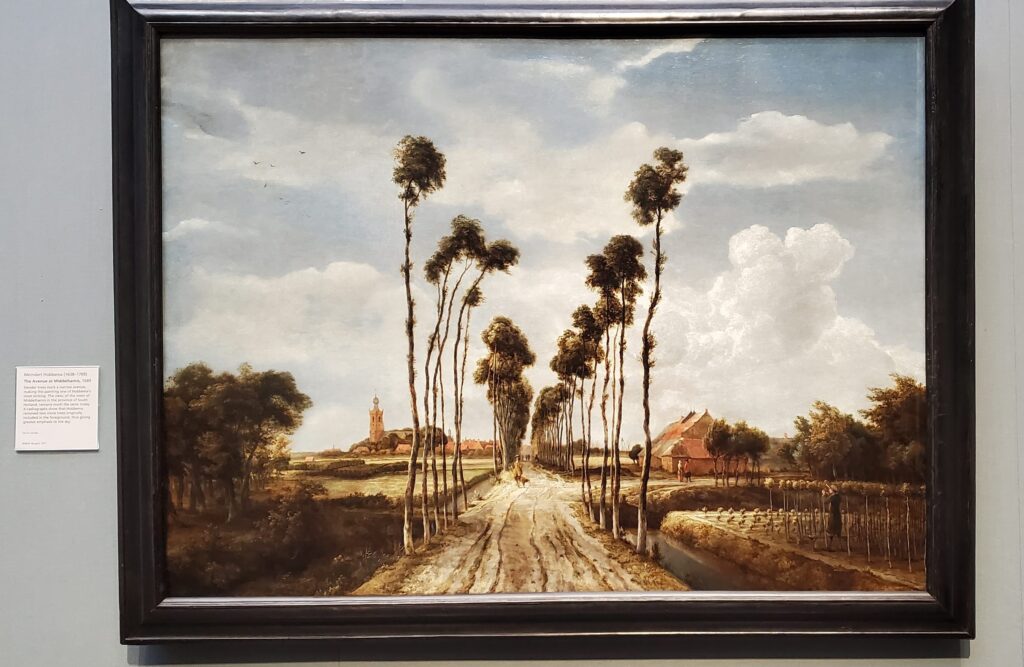
The second journey
Recently I was unexpectedly in London. Besides meetings, I visited the National Gallery on three consecutive days. I went to see A View of Delft by Fabritius, so beloved by Cummings. I tracked down original paintings hanging in the National Gallery that my father had copied. I bought A Closer Look at Pictorial Space by Nicholas Penny, one in a series of National Gallery guidebooks and read about all the mentioned paintings on display while there and able to examine them closely. Amazing. One was The Avenue at Middleharnis by Meindert Hobbema. Cummings also discusses it in Thunderclap. My father painted a copy. I think that this may have been his favourite painting although his copy did not appeal as much to me. I appreciated the much larger original which I could examine both up close and from afar.
I sought out the location of the original Richmond House on the Thames in London. After the fire it was replaced by Richmond Terrace. In 1987 it was rebuilt again and became a government building, currently under renovation to temporarily house Parliament beginning in 2025 when Westminster Palace will undergo renovations for six years. I was on the Embankment level and not a second-floor window, but the view bore no resemblance to “my” painting. I could glimpse St. Paul’s Cathedral, but the Thames was bisected now by multiple bridges, the skyline was stuffed with modern buildings and commercial docks crowded the foreground. The grey sky did not help – there was none of the brightness and sense of space evoked by the painting. It was disappointing but perhaps irrational to have expected to glimpse something of what Canaletto saw.
Satiated with art, I wandered back to the hotel from the National Gallery on the last day, exploring new streets and absorbing more of London. Coincidently I found myself outside of the Wallace Collection. I had not previously heard of it, but it was open, entrance was free. I popped in, thinking that it would give me a feel for what Richmond House might have been like and perhaps how my Canaletto might be placed in Goodwood House in Sussex. There are several views of Venice by Canaletto in the Wallace Collection. Reflecting on the changes in London since Canaletto visited and painted, I finally appreciated how remarkable Venice really is, its skyline almost the same today as in the 1700’s. What an excellent journey Canaletto’s Thames painting has taken me on.
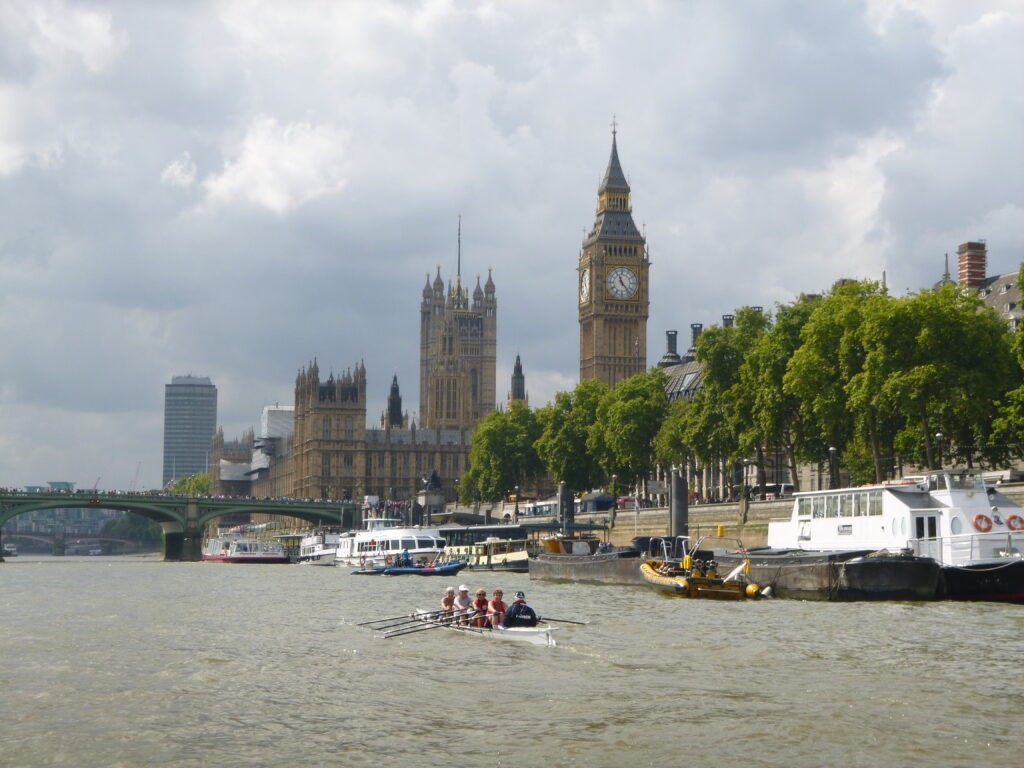
Hi, one of Caneletto famous painting is that of Greenwich, London the picture is almost unchanged, and where I row from with Globe Rowing club. It is of the Old Royal Navel College with Thames watermen going about their business of water taxi’s.
Hi Ken, Thanks very much for sharing this. I am delighted to hear this. When I am next in London I will go and check the views. And your rowing club! Ruth